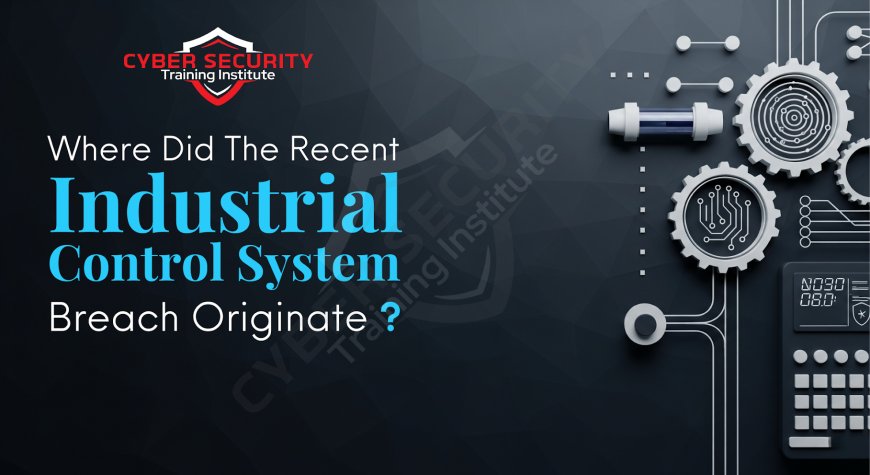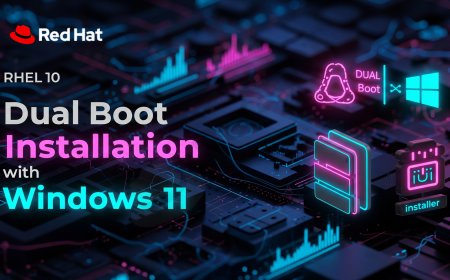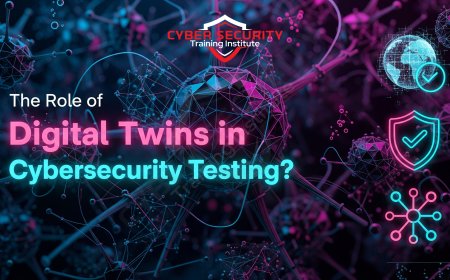Where Did the Recent Industrial Control System (ICS) Breach Originate?
A major breach at an Indian port's Industrial Control System (ICS) originated not from a direct OT assault, but from a compromised third-party on the IT network. Discover the full attack path and the critical security failures involved. This detailed analysis from Pune, India on July 30, 2025, investigates the origin of the recent, disruptive cyber-attack on the JNPT automated terminal. Forensic evidence reveals a multi-stage kill chain that began with a phishing attack on a contractor, followed by a pivot from the corporate IT network to the Operational Technology (OT) network through a misconfigured firewall. The article breaks down the systemic failures in IT/OT segmentation and third-party risk management that enabled the attack and provides a guide for building a resilient OT security posture to defend critical infrastructure.

Table of Contents
- Introduction
- IT vs. OT Security: A Tale of Two Worlds Colliding
- The Strategic Targeting of Critical Infrastructure in 2025
- Tracing the Intrusion: The Multi-Stage Kill Chain
- Forensic Analysis: Tracing the Breach's Origin
- The Perfect Storm: Systemic Failures that Allowed the Breach
- The Role of AI in both Attack and Defense
- Building a Resilient OT Security Posture
- Conclusion
- FAQ
Introduction
The recent cyber-attack on the automated container terminal at Jawaharlal Nehru Port Trust (JNPT) has sent a chilling message across India's industrial sector. This was not another data breach aimed at stealing customer information; this was a direct assault on the nation's critical infrastructure, causing significant physical and economic disruption. For days, the flow of goods was paralyzed as investigators worked to understand the intrusion. The initial chaos has now subsided, but the urgent work of digital forensics continues. The question everyone from Mumbai to Delhi is asking is not just what happened, but a more fundamental one: Where did the recent Industrial Control System (ICS) breach originate?
IT vs. OT Security: A Tale of Two Worlds Colliding
To understand the origin of this attack, one must first understand the two different worlds that collided. Information Technology (IT) networks are the corporate systems we all know—email, servers, and databases. Their security priority is the Confidentiality, Integrity, and Availability (CIA) of data. Operational Technology (OT), however, runs the physical world—the machinery in factories, the grid in power plants, and the cranes at a port. For decades, OT networks were isolated ("air-gapped"), and their security priority was Safety and Availability preventing physical harm and ensuring uptime. The drive for "smart" industrial automation in the 2020s connected these two worlds, creating a new, poorly understood attack surface at the IT/OT boundary The Strategic Targeting of Critical Infrastructure in 2025
The attack on JNPT was not a random act of vandalism. The targeting of industrial and critical infrastructure has become a key objective for nation-state adversaries for several reasons:
- Geopolitical Leverage: The ability to disrupt a nation's trade, power, or water supply is a powerful tool of coercion in international relations.
- Economic Warfare: Paralyzing a major port, even for a few days, has a massive cascading effect on the national and global economy.
- Vulnerable Legacy Systems: Many OT systems were designed decades ago with no security in mind. Connecting them to the internet for remote monitoring has exposed these fragile systems to modern threats.
- Testing Cyber-Warfare Capabilities: For some adversaries, these attacks are live-fire exercises, allowing them to test their capabilities and map the defenses of a rival nation's critical infrastructure.
Tracing the Intrusion: The Multi-Stage Kill Chain
Forensic evidence indicates the attackers followed a patient, multi-stage path to bridge the IT/OT divide:
- 1. Initial Access (The IT Network): The attackers did not target the port directly. Instead, they compromised a trusted third-party—a maintenance contractor responsible for servicing the terminal's HVAC systems.
- 2. Pivot from IT to OT: Using the contractor's stolen VPN credentials, the attackers gained access to the port's corporate IT network. From there, they exploited a poorly configured firewall rule that allowed traffic to pass from the IT network into the supposedly secure OT network.
- 3. Compromise of the OT Environment: Once inside the OT network, they moved laterally, finding a Human-Machine Interface (HMI) terminal that was still using its default factory password.
- 4. Manipulation of Physical Processes: From the compromised HMI, the attackers sent malicious commands to the Programmable Logic Controllers (PLCs) that control the container cranes, causing them to halt operations and report false status information.
Forensic Analysis: Tracing the Breach's Origin
The digital breadcrumbs, when pieced together, reveal a clear path from the outside world to the core of the industrial controls:
| Stage in Kill Chain | Point of Origin / Vector | Key Evidence | Attributed Threat Actor TTPs |
|---|---|---|---|
| Initial Reconnaissance | Public Internet (LinkedIn, Vendor Websites) | Publicly available information identifying maintenance contractors for the port authority. | Standard OSINT (Open-Source Intelligence) gathering used by most sophisticated actors. |
| Initial Access | Phishing Email to Third-Party Contractor | A weaponized PDF, likely AI-generated, was sent to a contractor's employee, leading to credential theft. | Consistent with tactics used by groups like APT41 and FIN7 for initial access. |
| IT Network Intrusion | Contractor's Stolen VPN Credentials | VPN logs show a login from an IP address associated with a known malicious VPS provider. | Classic "trusted relationship" abuse, a hallmark of state-sponsored espionage groups. |
| Pivot to OT Network | Misconfigured Firewall Rule | Firewall logs show RDP traffic initiated from an IT workstation to an HMI terminal in the OT network. | Exploitation of weak network segmentation, a common tactic used by ICS-focused groups like Sandworm and XENOTIME. |
| Physical Disruption | Compromised HMI Terminal | HMI logs (partially erased) show unauthorized commands sent to PLCs using a legitimate but stolen operator account. | Manipulation of industrial protocols (e.g., Modbus) to affect physical processes, the most dangerous and specialized capability. |
The Perfect Storm: Systemic Failures that Allowed the Breach
This was not a single failure, but a cascade of them. The breach was made possible by several common, yet critical, security gaps:
- Inadequate Third-Party Risk Management: The ultimate origin was a compromised contractor. The port authority's security did not sufficiently extend to its supply chain partners.
- Poor IT/OT Segmentation: A firewall existed, but a single misconfigured rule was all it took for the attackers to cross from the less-secure IT world into the critical OT environment.
- Weak Authentication in OT: The use of default passwords and the lack of Multi-Factor Authentication on critical HMI terminals is a pervasive and dangerous issue in many industrial environments.
- Lack of OT Network Visibility: The attackers were able to move laterally within the OT network undetected because there was no dedicated monitoring solution (like an OT-specific NDR) in place to spot the anomalous traffic.
The Role of AI in both Attack and Defense
AI played a role on both sides of this conflict. The attackers likely used AI to:
- Craft the initial phishing lure to make it highly convincing.
- Map the complex OT network after gaining access, identifying the critical HMI and PLC targets far faster than a human could.
Conversely, the future of OT defense relies on AI. Specialized OT security platforms use AI to:
- Baseline normal OT traffic, which is highly predictable, to instantly spot any anomalous command sent to a PLC.
- Detect threats without impacting performance, as passive network monitoring doesn't risk crashing fragile legacy OT systems.
Building a Resilient OT Security Posture
For industrial organizations across India, the JNPT breach must serve as a final wake-up call. Building a defensible architecture requires several key steps:
- Enforce Strict IT/OT Segmentation: Implement a robustly configured "demilitarized zone" (DMZ) between IT and OT networks, ensuring no direct traffic can pass between them.
- Deploy OT-Specific Monitoring: You cannot protect what you cannot see. Deploy a passive Network Detection and Response (NDR) tool specifically designed to understand industrial protocols (like Modbus, DNP3, etc.).
- Secure Remote Access: Eliminate standing VPN access for third parties. Move to a Zero Trust Network Access (ZTNA) model that grants temporary, granular access only to specific systems for specific tasks.
- Conduct Regular OT Incident Response Drills: Your IT incident response plan will not work for OT. Practice scenarios that involve containing threats on the OT network while maintaining operational safety.
Conclusion
The forensic evidence is clear: the devastating breach at the JNPT terminal did not originate from a sophisticated, direct assault on a hardened industrial controller. It originated from a classic IT weakness—a phishing email sent to a third-party contractor. The true failure was the porous boundary between the IT and OT worlds, which allowed a simple intrusion to escalate into a national-level critical infrastructure incident. This attack serves as a stark reminder that in our hyper-connected world, industrial cybersecurity is no longer just about protecting machinery; it's about securing the entire converged ecosystem, from the corporate inbox to the factory floor.
FAQ
What is an Industrial Control System (ICS)?
ICS is a general term for the computer systems used to monitor and control industrial processes. This includes SCADA systems, PLCs, and Distributed Control Systems (DCS).
What is the difference between IT and OT?
IT (Information Technology) refers to systems that manage data (e.g., servers, email, databases). OT (Operational Technology) refers to systems that manage physical processes and machinery (e.g., factory robots, power grid controllers).
What is a PLC (Programmable Logic Controller)?
A PLC is a ruggedized industrial computer that is the frontline controller for a specific piece of machinery, like a single robotic arm or a valve on a pipeline. The attack targeted the PLCs controlling the container cranes.
What is an HMI (Human-Machine Interface)?
An HMI is the graphical screen or terminal that a human operator uses to monitor and interact with the PLCs and the industrial process.
What does "air-gapped" mean?
An air-gapped system is one that is physically isolated from any other network, including the internet. For decades, this was the primary security model for OT systems, but it is rarely true anymore.
Why was a third-party contractor targeted?
Attackers often target the "weakest link." A smaller contractor may have less sophisticated security than the primary target, but still has trusted access, making them an ideal entry point.
What is network segmentation?
It is the practice of dividing a network into smaller, isolated sub-networks or segments. Proper segmentation between IT and OT would have prevented the attacker from moving from the corporate network to the industrial controls.
What is SCADA?
SCADA (Supervisory Control and Data Acquisition) is a type of ICS that allows for remote monitoring and control of industrial processes over large distances, such as a pipeline or an electrical grid.
Is this breach similar to the Stuxnet attack?
It shares similarities in that it targets an ICS to cause physical effects. However, Stuxnet was an extremely sophisticated weapon that used multiple zero-day exploits. This attack appears to have used more common techniques, exploiting poor security hygiene rather than unknown vulnerabilities.
What is a "trusted relationship" attack?
This is when an attacker compromises a smaller organization (like a supplier or contractor) to use their trusted position and credentials to attack a larger, primary target.
What is an OT-specific NDR tool?
It is a Network Detection and Response platform that is specifically designed to understand industrial network protocols (like Modbus or Profinet), which are very different from standard IT protocols (like HTTP).
Why are default passwords such a big problem in OT?
Many industrial devices are installed and then run for years without being changed. It is very common for engineers to leave the factory-default passwords on these devices, which are often publicly known and provide an easy entry point for attackers.
What is a DMZ in the context of IT/OT?
A DMZ (demilitarized zone) is a small, isolated network that sits between the IT and OT networks. It acts as a buffer zone where data can be safely exchanged without allowing direct traffic between the two environments.
What is the role of CERT-In in this incident?
The Indian Computer Emergency Response Team (CERT-In) would be the lead national agency coordinating the investigation, performing digital forensics, and issuing alerts and guidance to other critical infrastructure operators.
What is a kill chain?
A cyber kill chain is a model that describes the different stages of a cyber-attack, from the initial reconnaissance to the final objective. Analyzing an attack in terms of the kill chain helps defenders understand where their controls failed.
How can a company secure its supply chain?
Through robust Third-Party Risk Management (TPRM) programs, which include security assessments, mandating security standards in contracts, and limiting the access that any third party has to the bare minimum required for their job.
What is a Zero Trust Network Access (ZTNA) solution?
ZTNA is a modern approach to remote access. Instead of a traditional VPN that gives a user broad network access, ZTNA grants access only to specific applications on a case-by-case basis after verifying the user and device identity.
Can you really use AI to hack an OT system?
Yes. An attacker can use AI to rapidly learn the complex physics and timing of an industrial process, allowing them to craft malicious commands that cause maximum disruption without immediately triggering safety alarms.
What is the number one lesson from this breach?
The number one lesson is that your OT security is only as strong as your IT security. A simple IT failure, like a compromised password, can lead to catastrophic physical consequences if the boundary between the two worlds is not properly secured.
Are other ports in India at risk?
Yes. The vulnerabilities and systemic failures that led to this breach are common across many industrial sectors and critical infrastructure facilities in India and worldwide, making this a crucial wake-up call for all operators.
What's Your Reaction?
 Like
0
Like
0
 Dislike
0
Dislike
0
 Love
0
Love
0
 Funny
0
Funny
0
 Angry
0
Angry
0
 Sad
0
Sad
0
 Wow
0
Wow
0















